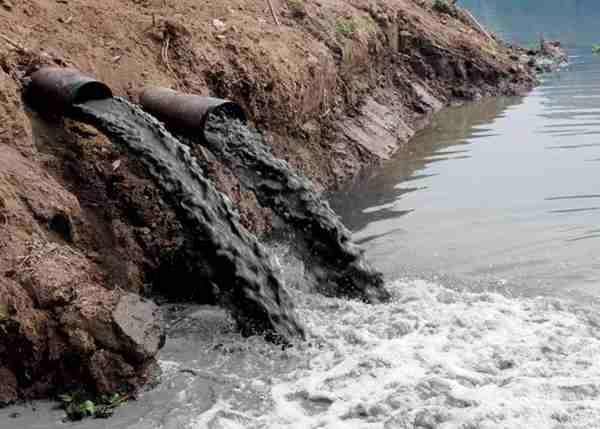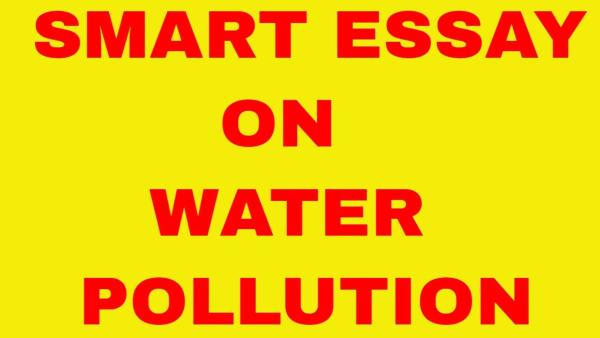जल प्रदूषण को कई तरह से परिभाषित किया जा सकता है। आमतौर पर, इसका मतलब है कि एक या एक से अधिक पदार्थों ने पानी में इस हद तक निर्माण किया है कि वे जानवरों या लोगों के लिए समस्या पैदा करते हैं। महासागरों, झीलों, नदियों और अन्य अंतर्देशीय जल प्राकृतिक रूप से प्रदूषण की एक निश्चित मात्रा को नुकसान पहुंचाकर प्राकृतिक रूप से साफ कर सकते हैं। यदि आप एक काली स्याही का कप नदी में डालते हैं, तो स्याही जल्दी से नदी के स्वच्छ पानी की बड़ी मात्रा में गायब हो जाएगी। नदी में अभी भी स्याही मौजूद होगी, लेकिन इतनी कम सांद्रता में कि आप इसे देख नहीं पाएंगे।
An essay on water pollution
Water pollution is the pollution of bodies of water, such as lakes, rivers, seas, the oceans, as well as groundwater. It occurs when pollutants reach these bodies of water, without treatment. Waste from homes, factories and other buildings get into the water bodies.
Water pollution is a problem for the species and ecosystems there. It affects plants and organisms living in the water. In almost all cases the effect is damaging not only to individual species and populations, but also to the wider biological communities. The color is usually green or brown but normal water can be blue.
Agriculture is one of the major sources of water pollution. The fertilizers given to the crops for better growth are washed into rivers and lakes, which in turn pollutes the water.
There are many chemicals that are naturally found in these bodies of water. Today water may be polluted by nitrates, phosphates, oil, acid rain, and debris such as sediment, fallen logs and so on. When people and animals drink water from such rivers, the poisonous chemicals may affect them. Life in rivers are also affected, and humans who consume fish may also have health problems.[1]
Essay on water pollution in hindi
प्रस्तावना : विज्ञान के इस युग में मानव को जहां कुछ वरदान मिले है, वहां कुछ अभिशाप भी मिले हैं। प्रदूषण एक ऐसा अभिशाप हैं जो विज्ञान की कोख में से जन्मा हैं और जिसे सहने के लिए अधिकांश जनता मजबूर हैं।
प्रदूषण का अर्थ : प्रदूषण का अर्थ है -प्राकृतिक संतुलन में दोष पैदा होना। न शुद्ध वायु मिलना, न शुद्ध जल मिलना, न शुद्ध खाद्य मिलना, न शांत वातावरण मिलना।
प्रदूषण कई प्रकार का होता है! प्रमुख प्रदूषण हैं – वायु-प्रदूषण, जल-प्रदूषण और ध्वनि-प्रदूषण ।
वायु-प्रदूषण : महानगरों में यह प्रदूषण अधिक फैला है। वहां चौबीसों घंटे कल-कारखानों का धुआं, मोटर-वाहनों का काला धुआं इस तरह फैल गया है कि स्वस्थ वायु में सांस लेना दूभर हो गया है। मुंबई की महिलाएं धोए हुए वस्त्र छत से उतारने जाती है तो उन पर काले-काले कण जमे हुए पाती है। ये कण सांस के साथ मनुष्य के फेफड़ों में चले जाते हैं और असाध्य रोगों को जन्म देते हैं! यह समस्या वहां अधिक होती हैं जहां सघन आबादी होती है, वृक्षों का अभाव होता है और वातावरण तंग होता है।
जल-प्रदूषण : कल-कारखानों का दूषित जल नदी-नालों में मिलकर भयंकर जल-प्रदूषण पैदा करता है। बाढ़ के समय तो कारखानों का दुर्गंधित जल सब नाली-नालों में घुल मिल जाता है। इससे अनेक बीमारियां पैदा होती है।
ध्वनि-प्रदूषण : मनुष्य को रहने के लिए शांत वातावरण चाहिए। परन्तु आजकल कल-कारखानों का शोर, यातायात का शोर, मोटर-गाड़ियों की चिल्ल-पों, लाउड स्पीकरों की कर्णभेदक ध्वनि ने बहरेपन और तनाव को जन्म दिया है।
प्रदूषणों के दुष्परिणाम: उपर्युक्त प्रदूषणों के कारण मानव के स्वस्थ जीवन को खतरा पैदा हो गया है। खुली हवा में लम्बी सांस लेने तक को तरस गया है आदमी। गंदे जल के कारण कई बीमारियां फसलों में चली जाती हैं जो मनुष्य के शरीर में पहुंचकर घातक बीमारियां पैदा करती हैं। भोपाल गैस कारखाने से रिसी गैस के कारण हजारों लोग मर गए, कितने ही अपंग हो गए। पर्यावरण-प्रदूषण के कारण न समय पर वर्षा आती है, न सर्दी-गर्मी का चक्र ठीक चलता है। सुखा, बाढ़, ओला आदि प्राकृतिक प्रकोपों का कारण भी प्रदूषण है।प्रदूषण के कारण : प्रदूषण को बढ़ाने में कल-कारखाने, वैज्ञानिक साधनों का अधिक उपयोग, फ्रिज, कूलर, वातानुकूलन, ऊर्जा संयंत्र आदि दोषी हैं। प्राकृतिक संतुलन का बिगड़ना भी मुख्य कारण है। वृक्षों को अंधा-धुंध काटने से मौसम का चक्र बिगड़ा है। घनी आबादी वाले क्षेत्रों में हरियाली न होने से भी प्रदूषण बढ़ा है।
सुधार के उपाय : विभिन्न प्रकार के प्रदूषण से बचने के लिए चाहिए कि अधिक से अधिक पेड़ लगाए जाएं, हरियाली की मात्रा अधिक हो। सड़कों के किनारे घने वृक्ष हों। आबादी वाले क्षेत्र खुले हों, हवादार हों, हरियाली से ओतप्रोत हों। कल-कारखानों को आबादी से दूर रखना चाहिए और उनसे निकले प्रदूषित मल को नष्ट करने के उपाय सोचना चाहिए।
Essay on water pollution in english

Water pollution is defined as the addition of some substance (organic, inorganic, biological, and radiological) or factor (e.g., heat) which degrades the quality of water so that it either becomes health hazard or unfit for use.
Sources of Water Pollution and Effect of Water Pollutants:
1. Domestic Wastes and Sewage:
Raw sewage contaminates water with pathogens. Microorganisms causing degradation of sewage take up most of the oxygen present dissolved in water.
Sewage produces foul-odour and makes the water brownish and oily. Organic waste gives rise to scum and sludge that makes the water unfit for recreational and industrial use.It induces the growth of some algal blooms that add to the depletion of oxygen, addition of more organic matter and fouling of water. Modern day detergents degrade very slowly. They, therefore, accumulate and render the water unfit for human and animal use. The phosphates present in detergents further stimulate algal growth that add to the organic loading of water.
2. Surface Run-Off:
The pollutants present on the surface of land and fertilizers added to the soils” are washed down into water reservoirs and water courses during rains. This flow of fertilizer rich water into streams and lakes gives rise to eutrophication.3. Industrial Effluents:
They are industrial wastes which are allowed to pass into water bodies. The important toxic chemicals presents in them are:
(i) Mercury:
It is released during combustion of coal, smelting of metallic ores, chloralkali, paper and paint industries. Mercury is persistent. In water it gets changed into water soluble dimethyl form [(CH,) 2Hg)] and enters the food chain accompanied by biological or ecological amplification. Human beings feeding on poisoned animals and fishes develop a crippling deformity called minamata disease.
(ii) Lead:
The sources of lead pollution are smelters, battery, industry, paint, chemical and pesticide industries, automobiles’ exhausts, etc. It is mutagenic and causes anaemia, headache, and bluish lines round the gums.
(iii) Cadmium:
It shows biological amplification and accumulates inside kidneys, liver, pancreas and spleen. It causes renal damage, emphysema, hypertension, testicular necrosis and damage to placenta.
(iv) Other metals:
Copper, zinc, nickel, titanium, etc. cause toxaemia and change in enzyme functioning.
(v) Liquid Effluents:
Several types of liquid effluents containing toxic chemicals, acids and bases, are added to the rivers and other water bodies. They kill fish and other aquatic life besides being toxic to human beings. Some examples of large scale effluent addition into rivers are Yamuna (near Okhla, Delhi), Gomti (near Lucknow), Ganga (near Kanpur) and Hoogli (near Calcutta).
4. Thermal Pollution:
Many industrial processes are causing thermal pollution leading to higher temperatures. These industries do not contaminate the water supply, but use a lot of water for cooling purposes and return this water to the stream at a higher temperature, which affect the biotic components in the aquatic habitat. Warmer water holds less oxygen (14 ppm at 0°C, 1 ppm at 20°C) and hence its Biological Oxygen Demand (BOD) increases. Green algae are replaced by less desirable blue-green algae. Trout eggs fail to hatch while Salmon does not spawn at higher temperature.5. Marine Pollution:
Oceanic pollution is caused by ship-generated discharges of oil and petroleum products, noxious liquids, packaged dangerous goods, sewage, garbage etc. Migrating birds caught m the oil slicks losing their power of flight due to closer interlocking of barbules of the feathers, is common enough. Employment of detergents to clean the oil slicks has been found to be harmful to marine life.Eutrophication:
Any lake or sheet of fresh water, to begin with is oligotrophic, supporting a minimum of life forms. Therefore, its productivity would be minimal. But in times it comes to be occupied by immigrant life forms, which on death and decay would make further immigration possible.
The lake is then said to have reached a mesotrophic level. Finally, it comes to be occupied by a rich flora and fauna when it is said to have reached the eutrophic level i.e., when its productivity had reached its maximum. In nature, this would take place through thousands of years but with industrialisation and other forms of human activity, this process of eutrophication, as it is called is achieved into a few decades.
Degree of Water Impurity:
Water pollution by organic wastes is measured in terms of bio-chemical oxygen demand (BOD). BOD is defined as the amount of oxygen required by microorganisms to stabilize decomposable organic matter in waste under aerobic condition. It is oxygen required in milligrams for five days to metabolise waste present in one litre of water at 20°C. A weak organic waste will have BOD below 1500 mg/litre, medium between 1500—1400 mg/litre while a strong waste above it. Since BOD is limited to organic wastes, it is not a reliable method of measuring water pollution. Another slightly better mode is COD or chemical oxygen demand. It measures all oxygen consuming pollutant materials present in water.
जल प्रदूषण निबंध मराठी
पृथ्वी की सतह का दो तिहाई से अधिक भाग पानी से आच्छादित है; एक तिहाई से भी कम भूमि द्वारा लिया जाता है। जैसे-जैसे पृथ्वी की आबादी बढ़ती जा रही है, लोग ग्रह के जल संसाधनों पर लगातार दबाव डाल रहे हैं। एक तरह से, हमारे महासागरों, नदियों, और अन्य अंतर्देशीय जल को मानवीय गतिविधियों द्वारा “निचोड़ा” जा रहा है – इसलिए वे कम कमरा नहीं लेते हैं, लेकिन इसलिए उनकी गुणवत्ता कम हो जाती है। खराब पानी की गुणवत्ता का मतलब जल प्रदूषण है।
हम जानते हैं कि प्रदूषण एक मानवीय समस्या है क्योंकि यह ग्रह के इतिहास में एक अपेक्षाकृत हालिया विकास है: 19 वीं शताब्दी की औद्योगिक क्रांति से पहले, लोग अपने तत्काल पर्यावरण के साथ अधिक सामंजस्य रखते थे। चूंकि दुनिया भर में औद्योगीकरण फैल गया है, इसलिए प्रदूषण की समस्या इसके साथ फैल गई है। जब पृथ्वी की आबादी बहुत कम थी, तो किसी को भी विश्वास नहीं था कि प्रदूषण कभी भी एक गंभीर समस्या पेश करेगा। एक बार यह माना जाता था कि समुद्र प्रदूषित करने के लिए बहुत बड़े थे। आज, ग्रह पर लगभग 7 बिलियन लोगों के साथ, यह स्पष्ट हो गया है कि सीमाएं हैं। प्रदूषण उन संकेतों में से एक है जो मानव ने उन सीमाओं को पार कर लिया है।
समस्या कितनी गंभीर है? पर्यावरण अभियान संगठन डब्ल्यूडब्ल्यूएफ के अनुसार: “जहरीले रसायनों से होने वाले प्रदूषण से इस ग्रह पर जीवन खतरे में पड़ जाता है। हर महासागर और हर महाद्वीप, कटिबंधों से एक बार के प्राचीन ध्रुवीय क्षेत्रों में दूषित हो जाता है।”
Essay on water pollution for class 5
ऊपर हमने आपको जल प्रदुषण निबंध, जल प्रदूषण निबंध, jal pradushan nibandh marathi, essay on water pollution in marathi, pollution pdf, wikipedia, आदि की जानकारी दी है जिसे आप किसी भी भाषा जैसे Hindi, हिंदी फॉण्ट, मराठी, गुजराती, Urdu, उर्दू, English, sanskrit, Tamil, Telugu, Marathi, Punjabi, Gujarati, Malayalam, Nepali, Kannada के Language व Font में साल 2007, 2008, 2009, 2010, 2011, 2012, 2013, 2014, 2015, 2016, 2017 का full collection जिसे आप अपने स्कूल व सोशल नेटवर्किंग साइट्स जैसे whatsapp, facebook (fb) व instagram पर share कर सकते हैं|
Over two thirds of Earth’s surface is covered by water; less than a third is taken up by land. As Earth’s population continues to grow, people are putting ever-increasing pressure on the planet’s water resources. In a sense, our oceans, rivers, and other inland waters are being “squeezed” by human activities—not so they take up less room, but so their quality is reduced. Poorer water quality means water pollution.
We know that pollution is a human problem because it is a relatively recent development in the planet’s history: before the 19th century Industrial Revolution, people lived more in harmony with their immediate environment. As industrialization has spread around the globe, so the problem of pollution has spread with it. When Earth’s population was much smaller, no one believed pollution would ever present a serious problem. It was once popularly believed that the oceans were far too big to pollute. Today, with around 7 billion people on the planet, it has become apparent that there are limits. Pollution is one of the signs that humans have exceeded those limits.
How serious is the problem? According to the environmental campaign organization WWF: “Pollution from toxic chemicals threatens life on this planet. Every ocean and every continent, from the tropics to the once-pristine polar regions, is contaminated.”







